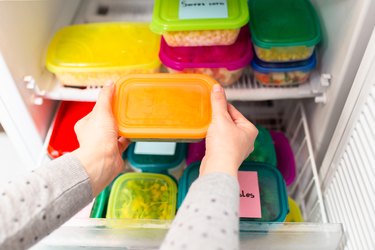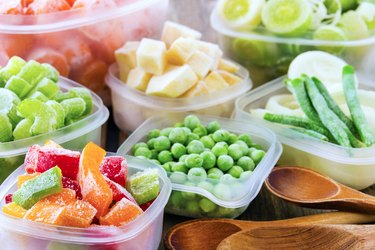
Cooking big batches and freezing food for the future is a smart strategy for saving time on meal prep during the week. Still, if you're unfamiliar with the best freezing methods, your once-delicious dishes might end up soggy or fraught with freezer burn.
This step-by-step guide takes the guesswork out of freezing food so your leftovers land on your plate just as palatable and fresh as they were before the deep freeze.
Video of the Day
Video of the Day
Step 1: Pick Freezer-Friendly Foods
Most foods freeze fantastically, including bread (a loaf or individual slices), many baked goods like muffins as well as soups, stews, braised dishes, meat and poultry, Abbie Gellman, RD, a NYC-based chef and registered dietitian, tells LIVESTRONG.com.
However, other foods get funky in the freezer. Produce with a high water content, such as watermelon, cucumbers and lettuce become limp and soggy when they thaw, according to Gellman. In other words, meals containing these fruits and veggies like salads are best served fresh when they're full of life.
"Beware of freezing anything creamy, like yogurt or milk," which will separate and curdle once defrosted, she says.
Cooked pasta (as opposed to baked pasta dishes like lasagna) doesn't hold up in the freezer well, either. After thawing, the once soft noodles transform into nothing more than a mound of mush.
Step 2: Cool Before Freezing
After cooking, always cool food before you place it in the refrigerator or freezer, Gellman says.
But why wait if your leftovers are already headed for the icebox? According to Gellman, "if you place hot food into a cool area, it will make the food around it warm and create warmth in the fridge or freezer."
That's a problem because bacteria can grow and cause foodborne illness when food isn't properly chilled and stored properly, she says.
For optimal safety, avoid the "danger zone," which is a range of temperatures between 40 and 140 degrees Fahrenheit that boasts the most growth of bad bacteria, per the USDA.
Items You'll Need to Freeze Leftovers
Step 3: Store Smaller Servings
Unless you plan on cooking for a large group, freezing food in smaller portions or individual servings is the way to go.
This allows you to just grab and go and encourages you to defrost only the amount you actually need, Gellman says.
Not only does this help you waste less food, it also makes reheating leftovers way quicker.
Freezing in smaller servings sizes is perfect for food like single slices of bread and big batches of oatmeal (use a muffin tin to freeze individual portions, then pop them out after they're frozen and transfer to a bag for proper storage).
Step 4: Pack to Preserve
To dodge the dreaded freezer burn and preserve your leftovers' quality, use freezer-specific bags or containers, removing as much air as possible before sealing.
And if you find that you're freezing foods frequently, consider investing in a vacuum sealer.
Also, try storing liquids like pureed soups or smoothies in bags and laying them flat in the freezer in thin layers. This saves room, helps food freeze faster and makes your leftovers easier to thaw later.
But keep in mind that liquid-based foods with a chunkier consistency like chili may do better in containers, Gellman says.
Related Reading
Step 5: Freeze Fast
As soon as your cooked food has cooled off, put it in the freezer. And if your icebox boasts a "quick-freeze" shelf, even better.
According to the USDA, the faster you freeze food, the fewer ice crystals that'll form. In other words, your leftovers will retain better quality.
To speed up the freezing process, spread out your pre-frozen packages like bags of soup or fillets of fish in one thin layer. The thinner your food item is, the faster it'll freeze.
Step 6: Label and Date
There's nothing more frustrating than forgetting how long your food has been in the deep freeze — not to mention wasteful, since you might have to toss out leftovers that have lingered too long.
To avoid this, always mark your freezer foods with helpful information.
Dating and labeling your leftovers is vital so that you know what's actually in that container or bag and the date which it was placed in the freezer, says Gellman, adding, "Some items, for example, should be used before 3 months (animal protein) while others can last 6 months (vegetables)."

How Long Leftovers Last in the Freezer
We all know that freezing preserves food, but for how long?
As long as the food was fresh prior to freezing, it can, theoretically, remain safe indefinitely, according to the USDA. Still, you probably don't want to munch on meat from the last millennium.
Below, these freezer storage charts provided by the USDA list optimum freezing times for food's best quality. (So note that while your leftovers may not be as good as they were fresh after the time ranges below, they'll still be safe to eat.)
Can't find a food on the charts? Assess its freshness after defrosting. Foods that aren't safe to eat often develop a rancid odor, per the USDA. Whenever you're unsure, simply discard. Always better to be safe than sorry.
Meats
Type of Meat | Months It Can Last Frozen |
|---|---|
Bacon and sausage | 1 to 2 |
Ham, hot dogs and lunch meats | 1 to 2 |
Meat, uncooked roasts | 4 to 12 |
Meat, uncooked steaks or chops | 4 to 12 |
Meat, uncooked ground | 3 to 4 |
Meat, cooked | 2 to 3 |
Poultry, uncooked whole | 12 |
Poultry, uncooked parts | 9 |
Poultry, uncooked giblets | 3 to 4 |
Poultry, cooked | 4 |
Wild game, uncooked | 8 to 12 |
Chicken nuggets or patties | 1 to 3 |
Other Types of Leftovers
Type of Food | Months It Can Last Frozen |
|---|---|
Casseroles | 2 to 3 |
Egg whites or egg substitutes | 12 |
Frozen dinners and entrees | 3 to 4 |
Gravy, meat or poultry | 2 to 3 |
Soups and stews | 2 to 3 |
Pizza | 1 to 2 |
Lean fish (flounder, haddock, halibut, etc.) | 6 to 8 |
Fatty fish (salmon, tuna, etc.) | 2 to 3 |
Was this article helpful?
150 Characters Max
0/150
Thank you for sharing!
Thank you for your feedback!